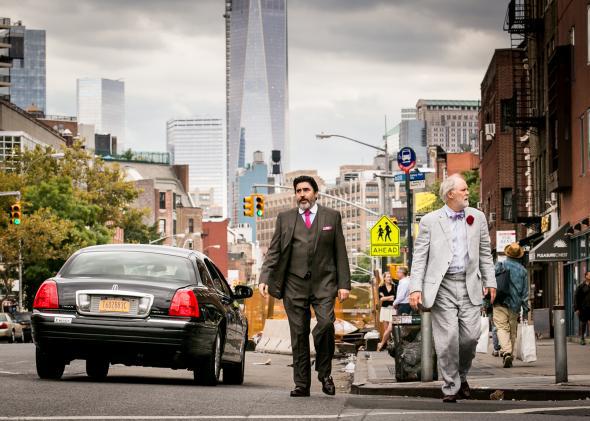Love Is Strange, a new film directed by Ira Sachs starring John Lithgow and Alfred Molina, will open tomorrow, and reception of the movie—which follows a longtime gay couple’s unexpected struggle with homelessness after they marry—has been highly positive. Slate’s Dana Stevens called the film a “delicate portrait of a long, loving relationship put to the test,” and the New York Times’ A.O. Scott praised Sachs for “beautifully captur[ing] the small pleasures and petty irritations [the two men] live through, and also their pride at having survived, together, for so long.”
That critics have uniformly described Love Is Strange as “small,” “delicate,” or some other variation on mild or quiet might lead you to infer something about its tone—something that stands in stark contrast to the R rating the Motion Picture Association of America has given it. Indeed, the disparity between the film’s content and the rating—one normally reserved for movies that prominently feature violence, sex, or crude language—is so great that film critic Stephen Whitty spent the entirety of his review in the Star-Ledger berating the MPAA, whose role is to offer guidance to parents on whether a film is appropriate for their children. “What are they assuming we want to protect our children from?” Whitty asks, going on to note Love Is Strange’s R-rated company at the box office this weekend:
On Friday, Sin City: A Dame to Kill For will be released in a wide number of theaters. It features nudity, sexual situations, and substance abuse. Every woman in it is a stripper, a prostitute, or a murderer. There is violence and graphic gore, including one scene of a man having his eye plucked out and another of a man having his fingers broken with a pliers. It is rated R.
That day, Jersey Shore Massacre also reaches theaters. It features nudity, sexual situations, substance abuse, and ethnic and racial slurs. There is violence and graphic gore, including one scene of a woman being disemboweled, another of a naked woman getting her breasts sliced open, and one of a man having his hands fed into a wood chipper. It is rated R.
To steal a phrase from a colleague, Love Is Strange is, in comparison, as clean as a Mister Rogers episode. Yes, there are a few stray curse words, but nothing that warrants more than a PG-13. Truly R-worthy offences are otherwise absent: There is no nudity, no sex, no skull-bashing or violence of any kind—unless you consider the (unfortunately realistic) situation of gay couple being forced out of job and home for registering their relationship with the state to be a form of violence.
So, to echo Whitty’s question, what is the “adult material” in Love Is Strange that might require “parental accompaniment” for moviegoers under the age of 17? Well, Lithgow and Molina do snuggle a lot. And they kiss and hug and express four decades’ worth of affection for each other. Ah, and there is some subtle intimation that one of the men’s nephews may be gay, too. Clearly, these offenses are just as worthy of parental trepidation as the grotesquerie of watching a woman have her breast sliced open on screen—or at least that’s how the MPAA seems to see it.
Let’s hope parents are smarter than this. There is nothing “adult” or at all worrisome about a movie that quietly and gently portrays a gay couple and their struggles. To think otherwise is to participate in an insidious sort of homophobia that uses child-sized human shields to disguise basic prejudice. And the worst part is that Love Is Strange is exactly the kind of “gay film” that younger teenagers, both gay and straight, would benefit from seeing. For the former group it offers a vision of a gay romantic future that, while beset with a specific struggle, is also full of love, as well as a sense of community and history—older, happy gay people exist! And for the straight kids, the film can reinforce the dignity of gays and their relationships in a way that abstract lectures never could.
If the critical praise is any indication, this is a film that everyone should see. Shame on the MPAA for making that more difficult for the demographic that might benefit from it the most.
